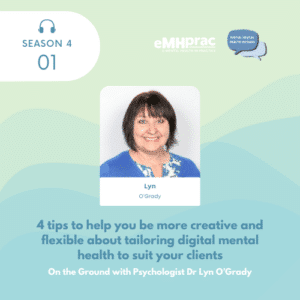In the mental health field, the concept of ‘blended care’ is gaining significant traction. For any readers unfamiliar with the term, ‘blended care’ essentially means integrating online and face-to-face care. For instance, a patient might see their GP or Psychologist for regular appointments while also completing modules from an online anxiety treatment course between visits or participating in an online peer support group.
While digital mental health tools and services offer numerous potential benefits to standard care, there are currently no clinical guidelines on how best to integrate them. This lack of guidance leaves many clinicians wondering, “Yes, but how…?” Especially with the overwhelming number of digital mental health tools and services available, putting blended care into practice can be daunting.
While there is exciting research happening in the space – check out our podcast episode from Season 3, Questions abound: “What tool is best for this or that situation?” “Should I stick to one tool or try lots of different ones?” “When and how should I introduce it?” “What if it doesn’t work—how much should I persist?”
For those of you who listen to our podcast, Digital Mental Health Musings, this is precisely why we’ve launched our brand new segment for this season, ‘On the Ground’. We want to find and share success stories from clinicians who are finding innovative ways to harness the benefits of digital mental health. These are the clinicians who are making digital mental health work for them and their patients and clients, and they have some fascinating insights.
If you haven’t already, check out our first episode of Season 4 with renowned Child Psychologist, Dr Lyn O’Grady, about the creative and flexible ways she has integrated digital mental health tools and services into her practice.
A key theme from the episode was the importance of patience, flexibility and trial and error when it comes to implementing a new skill or innovation into your practice. Dr O’Grady’s journey didn’t happen overnight, and it seems her patience, persistence and flexibility throughout the process were key factors that led to positive and lasting changes in how she works.
There is much we can learn from Dr O’Grady’s experience when examining our own personal journeys in this shift towards ‘blended care’. Interestingly, this would not be the first time that we as health professionals have had to exercise patience and flexibility, and even creativity in our work. In fact, we apply these skills all the time when we experience changes and updates to knowledge or practice guidelines. Changes to diagnoses, changes to language, changes to ‘best practice’—changes are occurring all the time, and many health professionals would agree that their practice ten years ago almost certainly looks quite different from their practice today—a testament to that fact.
As we reflect on this current shift in practice towards ‘blended care’, and where we might be in our own journey, it might be helpful to think about our past experiences of change. Consider the following questions:
- What was the last significant change I experienced in how I practice? How did I navigate it?
- How long has it typically taken me to adopt new changes into my practice? Big changes? Small changes?
- What do I imagine my practice might look like in five or even ten years from now? What small steps can I take now to move towards that?

Digital Mental Health Musings, Season 4 Episode 1
4 tips to help you be more creative and flexible about tailoring digital mental health to suit your clients: On the Ground with Psychologist Dr Lyn O’Grady





